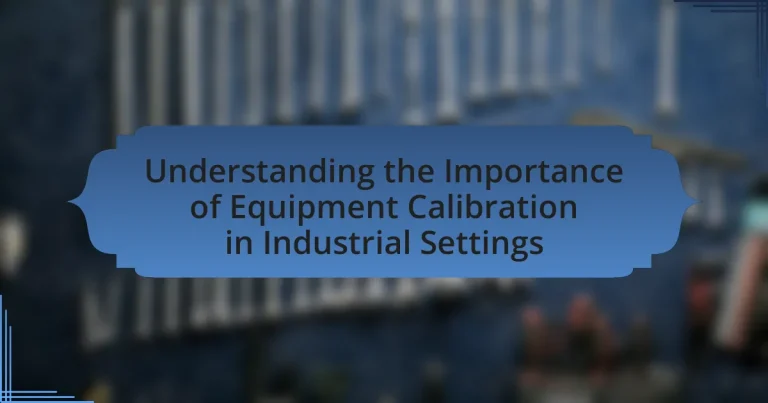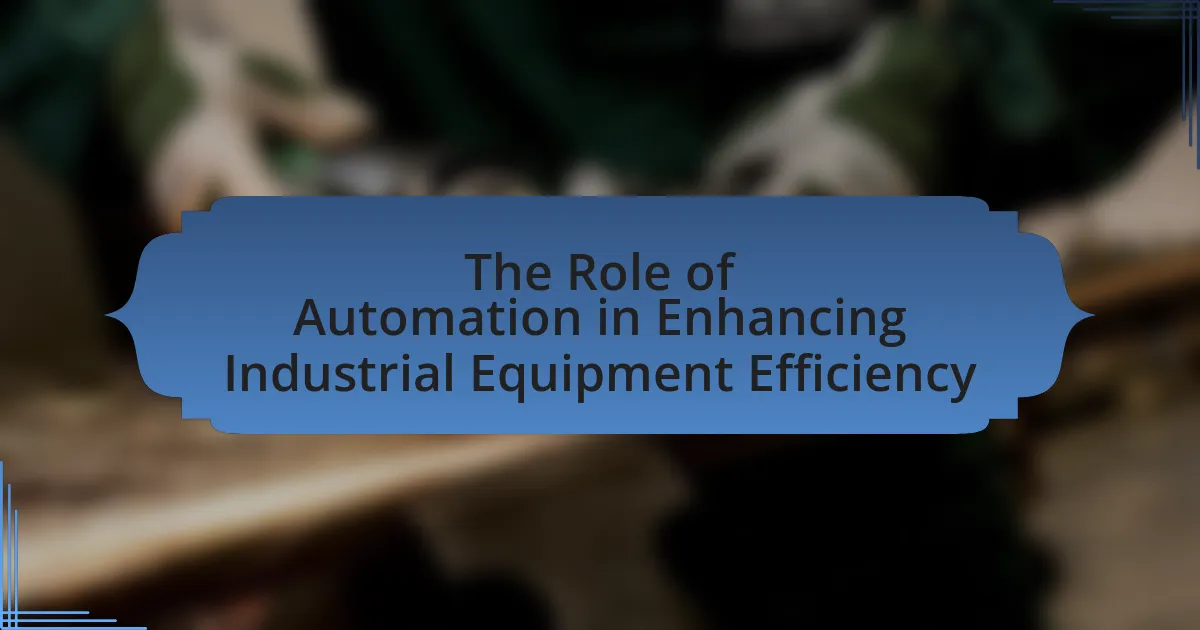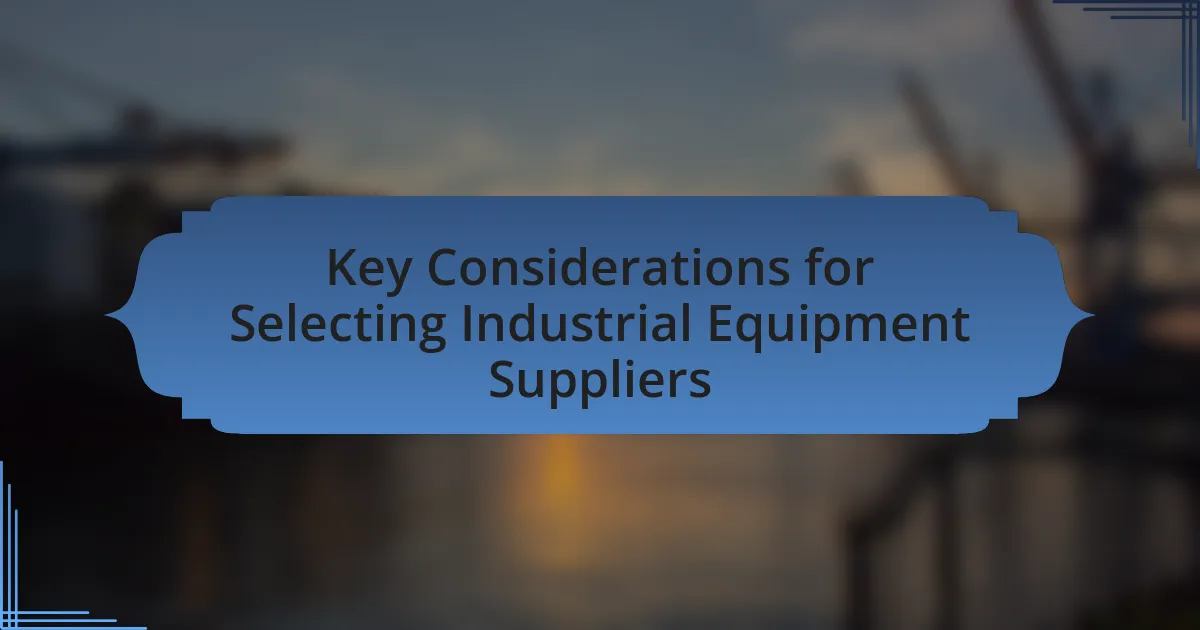Equipment calibration in industrial settings is a critical process that ensures the accuracy and reliability of measuring instruments and equipment. This article outlines the necessity of calibration for maintaining product quality, compliance with industry standards, and operational safety. It discusses the potential risks of neglecting calibration, including compromised product quality and increased operational costs, while emphasizing the key principles and standards governing calibration practices. Additionally, the article explores the impact of calibration on productivity, safety, and long-term savings, as well as the challenges industries face in implementing effective calibration processes. Finally, it highlights best practices and technological advancements that can enhance calibration accuracy and efficiency.
What is Equipment Calibration in Industrial Settings?

Equipment calibration in industrial settings is the process of verifying and adjusting the accuracy of measuring instruments and equipment to ensure they produce precise and reliable results. This process is essential for maintaining quality control, compliance with industry standards, and ensuring safety in operations. Calibration involves comparing the measurements of an instrument against a known standard and making necessary adjustments to align the instrument’s output with that standard. Regular calibration is mandated by various regulatory bodies, such as ISO and FDA, to ensure that equipment operates within specified tolerances, thereby reducing the risk of errors that could lead to product defects or safety hazards.
Why is Equipment Calibration Necessary?
Equipment calibration is necessary to ensure the accuracy and reliability of measurements taken by instruments. Accurate measurements are critical in industrial settings, as they directly impact product quality, safety, and compliance with regulatory standards. For instance, the National Institute of Standards and Technology (NIST) emphasizes that calibration helps maintain measurement traceability, which is essential for quality assurance and operational efficiency. Without proper calibration, equipment can produce erroneous data, leading to costly errors, safety hazards, and potential legal issues.
What are the potential risks of not calibrating equipment?
Not calibrating equipment poses significant risks, including inaccurate measurements, compromised product quality, and increased operational costs. Inaccurate measurements can lead to faulty data, resulting in poor decision-making and potential safety hazards. Compromised product quality may occur when equipment fails to meet specified tolerances, leading to defective products that can harm a company’s reputation and result in financial losses. Additionally, increased operational costs arise from inefficiencies and the need for rework or scrap due to non-compliance with standards. According to a study by the National Institute of Standards and Technology, improper calibration can lead to a 20% increase in operational costs in manufacturing settings.
How does calibration impact product quality?
Calibration directly impacts product quality by ensuring that measurement and control instruments operate within specified limits, leading to consistent and accurate production outcomes. Accurate calibration minimizes variability in manufacturing processes, which is crucial for maintaining product specifications and compliance with industry standards. For instance, a study by the National Institute of Standards and Technology found that improper calibration can lead to defects in up to 30% of manufactured products, highlighting the critical role of calibration in achieving high-quality outputs.
What are the key principles of Equipment Calibration?
The key principles of equipment calibration include accuracy, traceability, and consistency. Accuracy ensures that the measurements taken by the equipment are correct and reflect the true value of the parameter being measured. Traceability involves linking measurements to national or international standards, which provides a basis for comparison and validation. Consistency refers to the ability of the equipment to produce the same results under the same conditions over time. These principles are essential for maintaining quality control and compliance with industry regulations, as demonstrated by ISO 9001 standards, which emphasize the importance of calibration in ensuring product quality and reliability.
What standards govern equipment calibration practices?
The standards that govern equipment calibration practices include ISO/IEC 17025, which specifies general requirements for the competence of testing and calibration laboratories, and ANSI/NCSL Z540.3, which outlines requirements for calibration of measuring and test equipment. These standards ensure that calibration processes are consistent, reliable, and traceable to national or international measurement standards, thereby enhancing the accuracy and quality of measurements in industrial settings.
How often should equipment be calibrated?
Equipment should be calibrated at least once a year. This frequency is recommended to ensure accuracy and reliability in measurements, as equipment can drift over time due to wear and environmental factors. According to the International Organization for Standardization (ISO) guidelines, regular calibration helps maintain compliance with industry standards and ensures that equipment operates within specified tolerances, thereby reducing the risk of errors in production processes.
What are the common methods of Equipment Calibration?
Common methods of equipment calibration include comparison with a standard, adjustment to a known reference, and the use of calibration software. Comparison with a standard involves measuring the equipment’s output against a certified reference standard to identify discrepancies. Adjustment to a known reference entails modifying the equipment settings to align with the established standard values. Calibration software aids in automating the calibration process, ensuring accuracy and consistency in measurements. These methods are essential for maintaining precision and reliability in industrial settings, as they help ensure that equipment operates within specified tolerances, thereby enhancing product quality and safety.
What tools are used for calibration?
Calibration tools include precision instruments such as calibration weights, multimeters, temperature calibrators, pressure gauges, and calibration software. These tools are essential for ensuring that measuring devices maintain accuracy and reliability in industrial settings. For instance, calibration weights are used to verify the accuracy of scales, while multimeters measure electrical parameters to ensure devices operate within specified limits. Temperature calibrators are utilized to check thermometers and sensors, ensuring they provide accurate readings. Pressure gauges are employed to calibrate pressure measurement devices, confirming their precision. Calibration software aids in managing and documenting the calibration process, enhancing traceability and compliance with industry standards.
How do different calibration methods compare?
Different calibration methods, such as static calibration, dynamic calibration, and in-situ calibration, vary in their approach and effectiveness. Static calibration involves adjusting equipment under controlled conditions, ensuring accuracy at specific points, while dynamic calibration assesses performance during actual operation, providing a more comprehensive evaluation of equipment behavior. In-situ calibration allows for adjustments without removing equipment from its operational environment, which minimizes downtime. Studies indicate that dynamic calibration often yields more reliable results in real-world applications, as it accounts for variable conditions that static methods may overlook.
How does Equipment Calibration affect operational efficiency?
Equipment calibration significantly enhances operational efficiency by ensuring that machinery and instruments operate within specified tolerances. Accurate calibration minimizes errors in measurements and processes, leading to improved product quality and consistency. For instance, a study by the National Institute of Standards and Technology found that proper calibration can reduce production waste by up to 30%, directly impacting cost savings and resource utilization. Additionally, calibrated equipment reduces downtime caused by malfunctions or inaccuracies, thereby increasing overall productivity.
What are the cost implications of Equipment Calibration?
The cost implications of equipment calibration include both direct and indirect expenses that can significantly impact an organization’s budget. Direct costs involve the expenses associated with the calibration process itself, such as labor, equipment, and materials needed for accurate calibration. For instance, a study by the National Institute of Standards and Technology indicates that improper calibration can lead to production errors, which may cost companies up to 20% of their operational budget due to rework and waste. Indirect costs arise from potential downtime during calibration, loss of productivity, and the risk of non-compliance with industry standards, which can result in fines or loss of contracts. Therefore, while calibration incurs immediate costs, it ultimately serves to prevent larger financial losses associated with inaccurate measurements and operational inefficiencies.
What are the specific benefits of Equipment Calibration?

Equipment calibration ensures accuracy and reliability in measurements, which is crucial for maintaining product quality and compliance with industry standards. Accurate measurements reduce the risk of errors in production processes, leading to fewer defects and rework, ultimately saving time and costs. Calibration also enhances equipment lifespan by identifying potential issues before they lead to failure, thereby minimizing downtime. Furthermore, regular calibration helps organizations meet regulatory requirements, ensuring that they adhere to safety and quality standards, which can prevent legal issues and enhance customer trust.
How does Equipment Calibration enhance safety in industrial settings?
Equipment calibration enhances safety in industrial settings by ensuring that instruments and machinery operate within specified tolerances, thereby reducing the risk of malfunctions and accidents. Accurate calibration minimizes errors in measurements, which can lead to unsafe conditions, such as incorrect pressure readings in boilers or improper temperature settings in ovens. For instance, the National Institute of Standards and Technology (NIST) emphasizes that regular calibration can prevent equipment failure, which is critical in high-stakes environments like chemical plants or manufacturing facilities. By maintaining precise operational standards, calibration directly contributes to a safer workplace, protecting both personnel and equipment from potential hazards.
What role does calibration play in regulatory compliance?
Calibration plays a critical role in regulatory compliance by ensuring that measurement instruments and equipment operate within specified limits, thereby producing accurate and reliable data. Accurate measurements are essential for meeting industry standards and regulations, such as those set by the FDA, ISO, and other governing bodies, which require precise data for quality control, safety, and efficacy assessments. For instance, in pharmaceutical manufacturing, calibration of equipment is mandated to ensure that products meet safety and efficacy standards, as non-compliance can lead to significant legal and financial repercussions.
How can calibration prevent equipment failure?
Calibration can prevent equipment failure by ensuring that instruments and machinery operate within specified tolerances. Accurate calibration aligns equipment performance with manufacturer specifications, reducing the risk of malfunctions. For instance, a study by the National Institute of Standards and Technology found that regular calibration can decrease equipment failure rates by up to 30%, highlighting its critical role in maintaining operational integrity.
What impact does Equipment Calibration have on productivity?
Equipment calibration significantly enhances productivity by ensuring that machinery operates within specified tolerances, leading to consistent and accurate output. When equipment is properly calibrated, it minimizes errors and defects in production processes, which can otherwise result in costly rework and downtime. For instance, a study published in the Journal of Quality in Maintenance Engineering found that regular calibration of equipment can improve operational efficiency by up to 30%, as it reduces variability in production and increases the reliability of the equipment. This direct correlation between calibration and productivity underscores the critical role that precise measurements and adjustments play in maintaining optimal performance in industrial settings.
How does accurate calibration reduce downtime?
Accurate calibration reduces downtime by ensuring that equipment operates within specified tolerances, which minimizes the likelihood of malfunctions. When equipment is properly calibrated, it performs consistently and reliably, leading to fewer unexpected breakdowns. For instance, a study by the National Institute of Standards and Technology found that regular calibration can reduce equipment failure rates by up to 30%, directly impacting production efficiency. This reliability translates to less time spent on repairs and maintenance, thereby decreasing overall operational downtime.
What are the long-term savings associated with regular calibration?
Regular calibration leads to significant long-term savings by ensuring equipment operates at optimal efficiency, which reduces operational costs. Accurate measurements prevent costly errors, minimize waste, and enhance product quality, ultimately lowering the expenses associated with rework and scrap. For instance, a study by the National Institute of Standards and Technology found that proper calibration can reduce measurement uncertainty by up to 50%, leading to a decrease in production costs by approximately 10-20%. This financial benefit is compounded over time as consistent calibration maintains equipment reliability and extends its lifespan, further decreasing maintenance and replacement costs.
What are the challenges associated with Equipment Calibration?

The challenges associated with equipment calibration include maintaining accuracy, ensuring compliance with standards, and managing costs. Equipment calibration requires precise measurements and adjustments to ensure that instruments function correctly, which can be complicated by environmental factors such as temperature and humidity. Compliance with industry standards, such as ISO 9001, necessitates regular calibration, which can be resource-intensive and time-consuming. Additionally, the financial burden of calibration services and potential downtime during the calibration process can strain operational budgets. These challenges highlight the need for effective calibration management strategies to ensure reliability and efficiency in industrial settings.
What common obstacles do industries face in implementing calibration?
Industries commonly face several obstacles in implementing calibration, including lack of standardization, insufficient training, and high costs. Lack of standardization can lead to inconsistencies in calibration processes, making it difficult to ensure accuracy across different equipment and locations. Insufficient training of personnel can result in improper calibration techniques, which may compromise measurement reliability. High costs associated with calibration services and equipment can deter industries from maintaining regular calibration schedules, impacting overall operational efficiency. These challenges highlight the complexities involved in establishing effective calibration practices within industrial settings.
How can companies overcome resistance to calibration practices?
Companies can overcome resistance to calibration practices by implementing comprehensive training programs that emphasize the benefits of calibration. These programs should educate employees on how proper calibration enhances equipment performance, reduces errors, and ultimately leads to cost savings. Research indicates that organizations that invest in training see a 30% increase in compliance with calibration protocols, as employees become more aware of the direct impact on product quality and safety. Additionally, fostering a culture of open communication where employees can voice concerns and provide feedback about calibration processes can further reduce resistance.
What are the implications of inadequate training on calibration processes?
Inadequate training on calibration processes leads to significant errors in measurement accuracy and reliability. When personnel lack proper training, they may misinterpret calibration procedures, resulting in equipment that does not meet operational standards. This can cause production inefficiencies, increased downtime, and potential safety hazards, as equipment may operate outside of specified tolerances. Furthermore, studies indicate that organizations with poorly trained staff experience a higher rate of compliance issues, which can lead to regulatory penalties and damage to reputation. For instance, the National Institute of Standards and Technology emphasizes that proper training is essential for maintaining measurement integrity, highlighting the critical role of skilled personnel in calibration processes.
How can technology improve Equipment Calibration processes?
Technology can improve equipment calibration processes by enhancing accuracy, efficiency, and traceability. Advanced calibration software automates data collection and analysis, reducing human error and ensuring precise measurements. For instance, the integration of IoT devices allows real-time monitoring of equipment performance, enabling timely adjustments and reducing downtime. Furthermore, cloud-based systems facilitate centralized data management, making it easier to track calibration history and compliance with industry standards. According to a study published in the Journal of Quality in Maintenance Engineering, organizations that adopted automated calibration systems reported a 30% reduction in calibration time and a significant increase in measurement accuracy.
What advancements in technology are shaping calibration practices?
Advancements in technology shaping calibration practices include the integration of automation, artificial intelligence, and cloud computing. Automation enhances efficiency by reducing human error and speeding up the calibration process, while artificial intelligence enables predictive maintenance and real-time monitoring, allowing for more accurate adjustments. Cloud computing facilitates data storage and sharing, enabling remote access to calibration data and improving collaboration among teams. These technologies collectively lead to more precise, efficient, and reliable calibration practices in industrial settings.
How can automation enhance the accuracy of calibration?
Automation can enhance the accuracy of calibration by minimizing human error and ensuring consistent measurement conditions. Automated calibration systems utilize precise algorithms and sensors to perform adjustments and verifications, which reduces variability in results. For instance, studies have shown that automated calibration can achieve repeatability within ±0.01% of full scale, significantly improving accuracy compared to manual methods. Furthermore, automation allows for real-time data collection and analysis, enabling immediate corrections and adjustments, which further enhances the reliability of calibration processes.
What are best practices for effective Equipment Calibration?
Best practices for effective equipment calibration include establishing a clear calibration schedule, using certified calibration standards, and documenting all calibration activities. A clear schedule ensures that equipment is calibrated at regular intervals, which helps maintain accuracy and reliability. Utilizing certified standards guarantees that the calibration process adheres to recognized benchmarks, thereby enhancing the credibility of the results. Documentation of calibration activities provides a traceable record that can be referenced for compliance and quality assurance purposes. These practices collectively contribute to maintaining the integrity of measurements and ensuring operational efficiency in industrial settings.
How can organizations develop a calibration schedule?
Organizations can develop a calibration schedule by assessing the specific needs of their equipment and determining the frequency of calibration based on manufacturer recommendations, usage patterns, and regulatory requirements. This process involves identifying all equipment that requires calibration, categorizing them by criticality to operations, and establishing a timeline that aligns with operational demands and compliance standards.
For instance, the International Organization for Standardization (ISO) recommends that organizations maintain a calibration schedule that reflects the accuracy and reliability required for their processes, ensuring that all measuring and testing equipment is calibrated at regular intervals to meet quality assurance standards. By implementing a systematic approach, organizations can enhance operational efficiency and maintain compliance with industry regulations.
What tips can ensure successful calibration outcomes?
To ensure successful calibration outcomes, it is essential to follow a systematic approach that includes proper planning, execution, and documentation. First, establish a clear calibration schedule based on manufacturer recommendations and industry standards, which helps maintain consistency and reliability. Next, utilize calibrated reference standards that are traceable to national or international standards, ensuring accuracy in measurements. Additionally, train personnel thoroughly on calibration procedures and equipment handling to minimize human error. Finally, maintain detailed records of calibration activities, including results and any adjustments made, which supports compliance and facilitates future audits. These practices are supported by ISO 9001 standards, which emphasize the importance of documented procedures and traceability in achieving quality outcomes.




